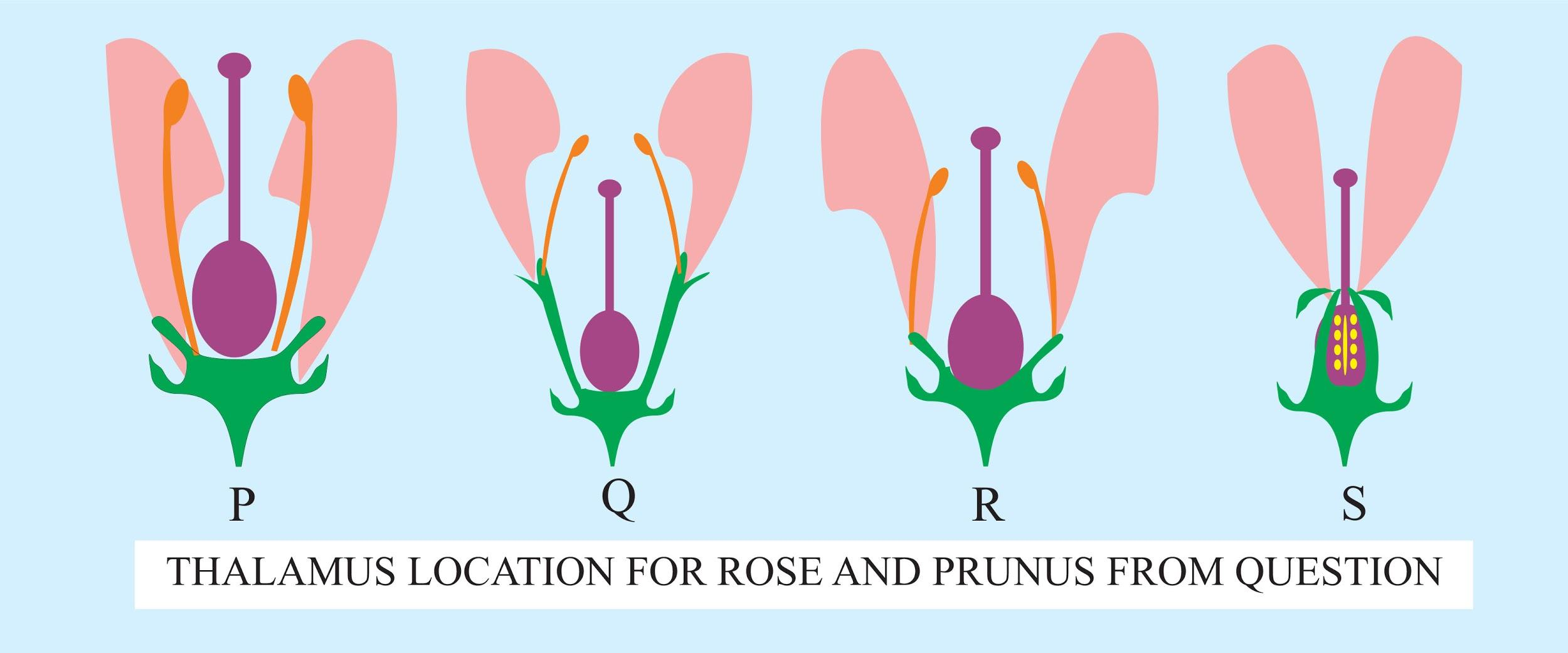
Based on the position of floral plants on the thalamus, the flowers are described as hypogynous, perigynous, and epigynous. Which of the following floral forms (P.S) represent the flowers of Rose and Prunus respectively.

(a) P and Q
(b) Q and R
(c) R and S
(d) Q and S

Answer
454.2k+ views
Hint: Rose is a flowering plant of genus Rosa which is known for its prickles. These prickles protect the flower from herbivores and facilitate bonding to other plants. Prunus is also known as ornamental cherry which is a large group of deciduous trees and is produced in springs in large masses of showy flowers. They have gynoecium attached to the receptacle.
Complete answer:
Q and R represent the flower of Rose and Prunus respectively. Perigynous flowers container concave or flat receptacle with which the gynoecium is attached. Rose and Prunus are periginous flowers. Rose is a Woody perennial flowering plant that was found in the temperate regions of the Northern hemisphere. They are cultivated for their beautiful flowers which range in colour from white to pink to dark crimson and maroon and yellow. They are known for their delightful fragrance which varies according to the climatic conditions. They contain thorns and over leaflets which are sharply toothed. Prunus visit a type of tree and shrub which includes cherries, peaches, apricot seeds, almonds, and plums.
Additional information:
Hypogynous: Hypogynous flowers contain gynoecium which occupies the highest position while the other parts are situated below it. The perianth and the stamens are attached to the receptacle below the gynoecium in hypogynous flowers. The point of origin of the carpel is for the arising of other remaining floral organs.
Epigynous: Epigynous flowers have floral parts such as petals and stamens which are attached to the ovary or near the upper part of the ovary. The hypanthium gets fused with the gynoecium and parts of the sepals, petals in stamens that are attached to the top of the gynoecium.
So, the correct answer is '(b) Q and R'.
Note: Galen identified the thalamus for the first time. He wanted to recall the thalamus of Odysseus. Burdach defined the thalamus and its macroscopic anatomy for the first time clearly and systematically. Thalamus supplies nutrients to the flower of the plant. The gynoecium is the female part that produces female gametes and develops into a female gametophyte which then produces egg cells.
Complete answer:
Q and R represent the flower of Rose and Prunus respectively. Perigynous flowers container concave or flat receptacle with which the gynoecium is attached. Rose and Prunus are periginous flowers. Rose is a Woody perennial flowering plant that was found in the temperate regions of the Northern hemisphere. They are cultivated for their beautiful flowers which range in colour from white to pink to dark crimson and maroon and yellow. They are known for their delightful fragrance which varies according to the climatic conditions. They contain thorns and over leaflets which are sharply toothed. Prunus visit a type of tree and shrub which includes cherries, peaches, apricot seeds, almonds, and plums.
Additional information:
Hypogynous: Hypogynous flowers contain gynoecium which occupies the highest position while the other parts are situated below it. The perianth and the stamens are attached to the receptacle below the gynoecium in hypogynous flowers. The point of origin of the carpel is for the arising of other remaining floral organs.
Epigynous: Epigynous flowers have floral parts such as petals and stamens which are attached to the ovary or near the upper part of the ovary. The hypanthium gets fused with the gynoecium and parts of the sepals, petals in stamens that are attached to the top of the gynoecium.
So, the correct answer is '(b) Q and R'.
Note: Galen identified the thalamus for the first time. He wanted to recall the thalamus of Odysseus. Burdach defined the thalamus and its macroscopic anatomy for the first time clearly and systematically. Thalamus supplies nutrients to the flower of the plant. The gynoecium is the female part that produces female gametes and develops into a female gametophyte which then produces egg cells.
Recently Updated Pages
Master Class 11 English: Engaging Questions & Answers for Success

Master Class 11 Computer Science: Engaging Questions & Answers for Success

Master Class 11 Maths: Engaging Questions & Answers for Success

Master Class 11 Social Science: Engaging Questions & Answers for Success

Master Class 11 Economics: Engaging Questions & Answers for Success

Master Class 11 Business Studies: Engaging Questions & Answers for Success

Trending doubts
One Metric ton is equal to kg A 10000 B 1000 C 100 class 11 physics CBSE

The sequence of spore production in Puccinia wheat class 11 biology CBSE

Petromyzon belongs to class A Osteichthyes B Chondrichthyes class 11 biology CBSE

Comparative account of the alimentary canal and digestive class 11 biology CBSE

Lassaignes test for the detection of nitrogen will class 11 chemistry CBSE

The type of inflorescence in Tulsi a Cyanthium b Hypanthodium class 11 biology CBSE




